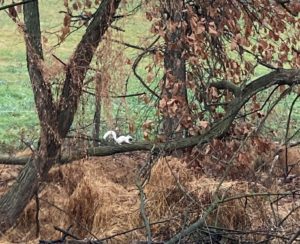
By Emily Domoto
When you see a squirrel, you might not think too much about it, and if you think anything, it is probably frustration as they eat your birdseed! But did you know that squirrels have spiritual meaning and symbolism? Well, I didn’t either until I saw a white morph squirrel and started googling, when I learned that squirrels are revered in some cultures as sacred animals. I wasn’t really looking for the meaning, more for the science, but I got sucked in pretty quickly.
Apparently, Hindu mythology places a great deal of importance on squirrels. They are known to have assisted Lord Rama, the Hindu God, in crossing the ocean between India and present-day Sri Lanka to get back Rama’s wife, who had been kidnapped by the demon-king Ravana who had ten heads. Other articles indicated that seeing squirrels may mean your future depends on investing in today, or that you need to add more fun to your life!
White squirrels are also known as mythological creatures that symbolize the coming of change and the need to prepare for it! Or, it could be a symbol of good luck, mainly because you don’t see them very often.
Scientifically speaking, white squirrels can be white morph or albino. A white morph squirrel is actually a genetic anomaly due to a mutated gene from the common Eastern gray squirrel. It is called leucism, which is a condition characterized by reduced pigmentation in animals caused by a recessive allele. Unlike albinism, it is a reduction in all types of skin pigment, not just melanin. White squirrels lack red eyes and sometimes have a gray patch on their heads and what is referred to as a “dorsal stripe” down their backs. Leucism is an inherited trait, so parents can pass it along to their offspring.
Albinism is a genetic condition caused by a recessive gene. This means that both parent squirrels must be carriers of this gene in order to produce albino offspring. This is what makes it so rare! It is estimated that 20-30% of white squirrels in North America are albino.
White morph and albino squirrels are both relatively rare, probably because being so brightly colored makes a squirrel less able to blend in amongst the trees and thus more visible to predators.
Not long after my husband and I moved in September, we spotted the afore-mentioned white squirrel in a small patch of woods by our house. I took a few pictures, figuring he wouldn’t be around too long since we have Cooper’s and red-tailed hawks around. I’m glad to report that four months later, “Alby”, our lucky squirrel, is still going strong.

Forest Fridays is a feature of the DCNR Bureau of Forestry.




